Strategic Business Project: Starbucks CSR in Hong Kong
VerifiedAdded on 2022/11/26
|60
|14567
|84
Project
AI Summary
This strategic business project examines the corporate social responsibility (CSR) initiatives of Starbucks within the food and beverage sector, specifically focusing on its operations in Hong Kong. The project investigates the importance of CSR in the industry, Starbucks' application of CSR strategies to meet business requirements, and the impact of these initiatives on brand image and market position. The research includes a literature review, research methodology, data presentation, and analysis, including quantitative data and graphical representations of customer preferences, knowledge, and perceptions of CSR. The study explores the challenges and opportunities associated with CSR implementation, including sustainable packaging, green initiatives, and the alignment of CSR with organizational and operational strategies. The project concludes with recommendations for future work, offering insights into how businesses in the food and beverage sector can effectively address CSR to create a balance between sustainability and profitability, ultimately attracting consumers who prioritize ethical and responsible practices. The project uses primary data collected through surveys to understand consumer perspectives and provides a detailed analysis of Starbucks' CSR efforts.
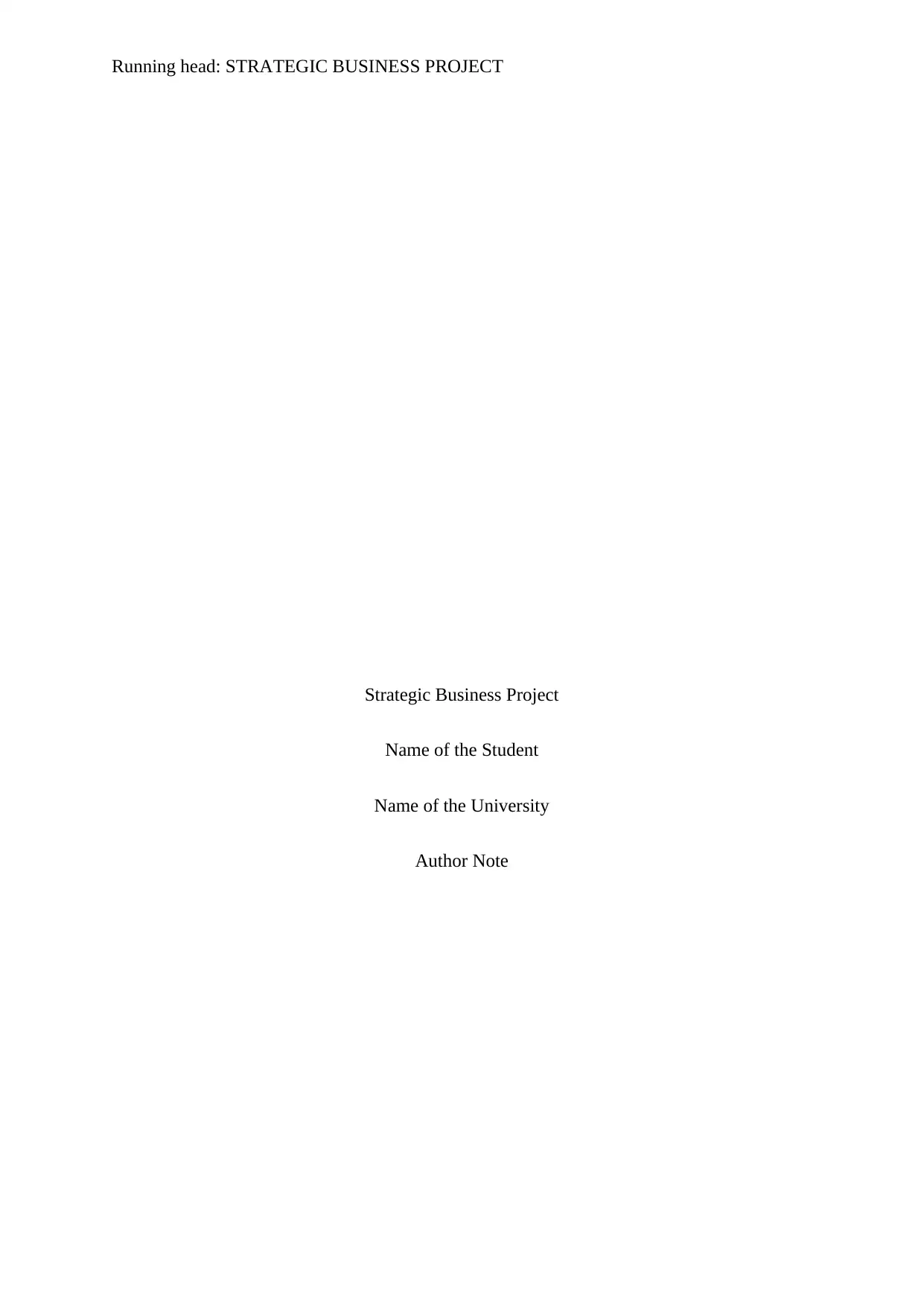
Running head: STRATEGIC BUSINESS PROJECT
Strategic Business Project
Name of the Student
Name of the University
Author Note
Strategic Business Project
Name of the Student
Name of the University
Author Note
Paraphrase This Document
Need a fresh take? Get an instant paraphrase of this document with our AI Paraphraser
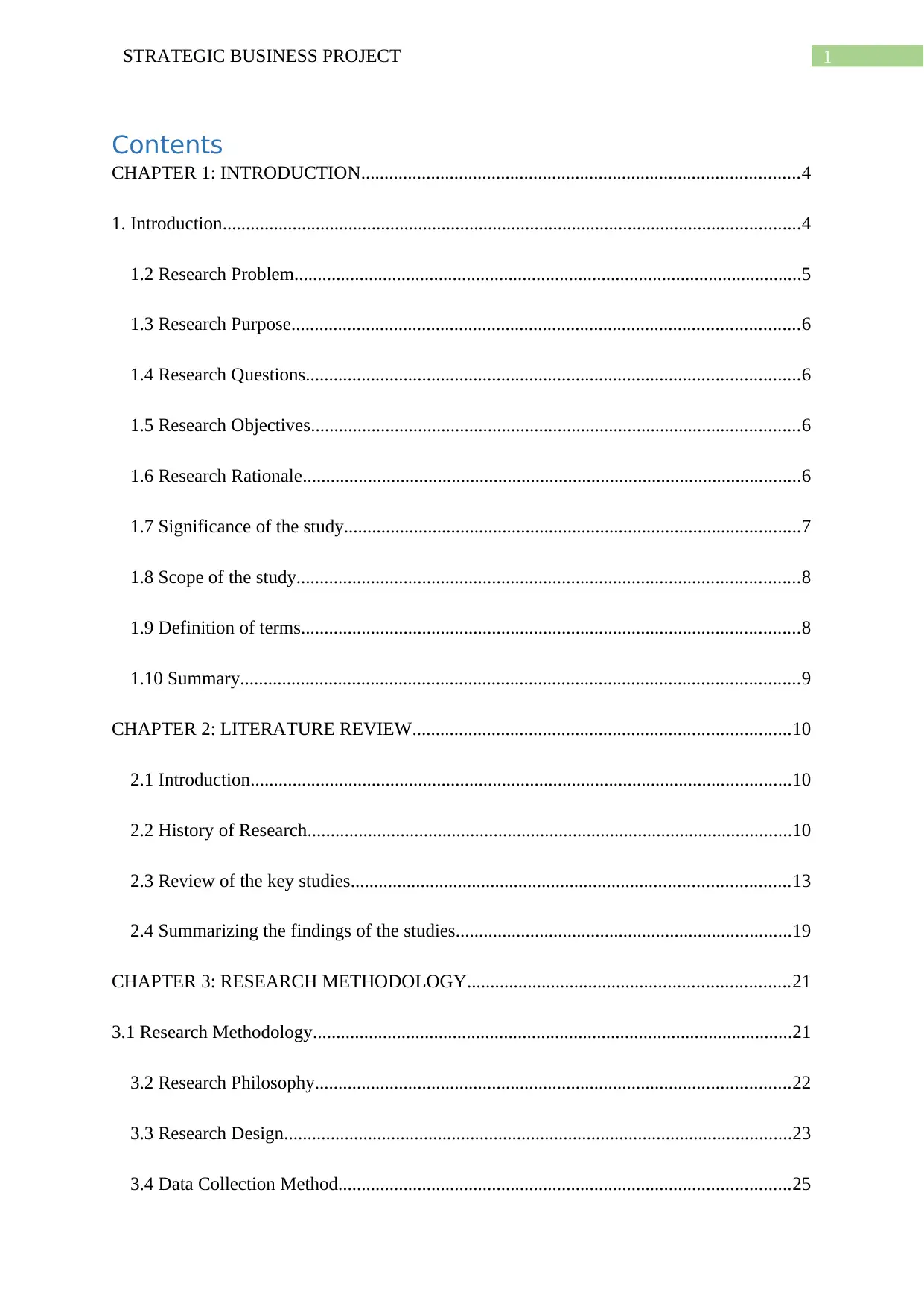
1STRATEGIC BUSINESS PROJECT
Contents
CHAPTER 1: INTRODUCTION..............................................................................................4
1. Introduction............................................................................................................................4
1.2 Research Problem.............................................................................................................5
1.3 Research Purpose.............................................................................................................6
1.4 Research Questions..........................................................................................................6
1.5 Research Objectives.........................................................................................................6
1.6 Research Rationale...........................................................................................................6
1.7 Significance of the study..................................................................................................7
1.8 Scope of the study............................................................................................................8
1.9 Definition of terms...........................................................................................................8
1.10 Summary........................................................................................................................9
CHAPTER 2: LITERATURE REVIEW.................................................................................10
2.1 Introduction....................................................................................................................10
2.2 History of Research........................................................................................................10
2.3 Review of the key studies..............................................................................................13
2.4 Summarizing the findings of the studies........................................................................19
CHAPTER 3: RESEARCH METHODOLOGY.....................................................................21
3.1 Research Methodology.......................................................................................................21
3.2 Research Philosophy......................................................................................................22
3.3 Research Design.............................................................................................................23
3.4 Data Collection Method.................................................................................................25
Contents
CHAPTER 1: INTRODUCTION..............................................................................................4
1. Introduction............................................................................................................................4
1.2 Research Problem.............................................................................................................5
1.3 Research Purpose.............................................................................................................6
1.4 Research Questions..........................................................................................................6
1.5 Research Objectives.........................................................................................................6
1.6 Research Rationale...........................................................................................................6
1.7 Significance of the study..................................................................................................7
1.8 Scope of the study............................................................................................................8
1.9 Definition of terms...........................................................................................................8
1.10 Summary........................................................................................................................9
CHAPTER 2: LITERATURE REVIEW.................................................................................10
2.1 Introduction....................................................................................................................10
2.2 History of Research........................................................................................................10
2.3 Review of the key studies..............................................................................................13
2.4 Summarizing the findings of the studies........................................................................19
CHAPTER 3: RESEARCH METHODOLOGY.....................................................................21
3.1 Research Methodology.......................................................................................................21
3.2 Research Philosophy......................................................................................................22
3.3 Research Design.............................................................................................................23
3.4 Data Collection Method.................................................................................................25
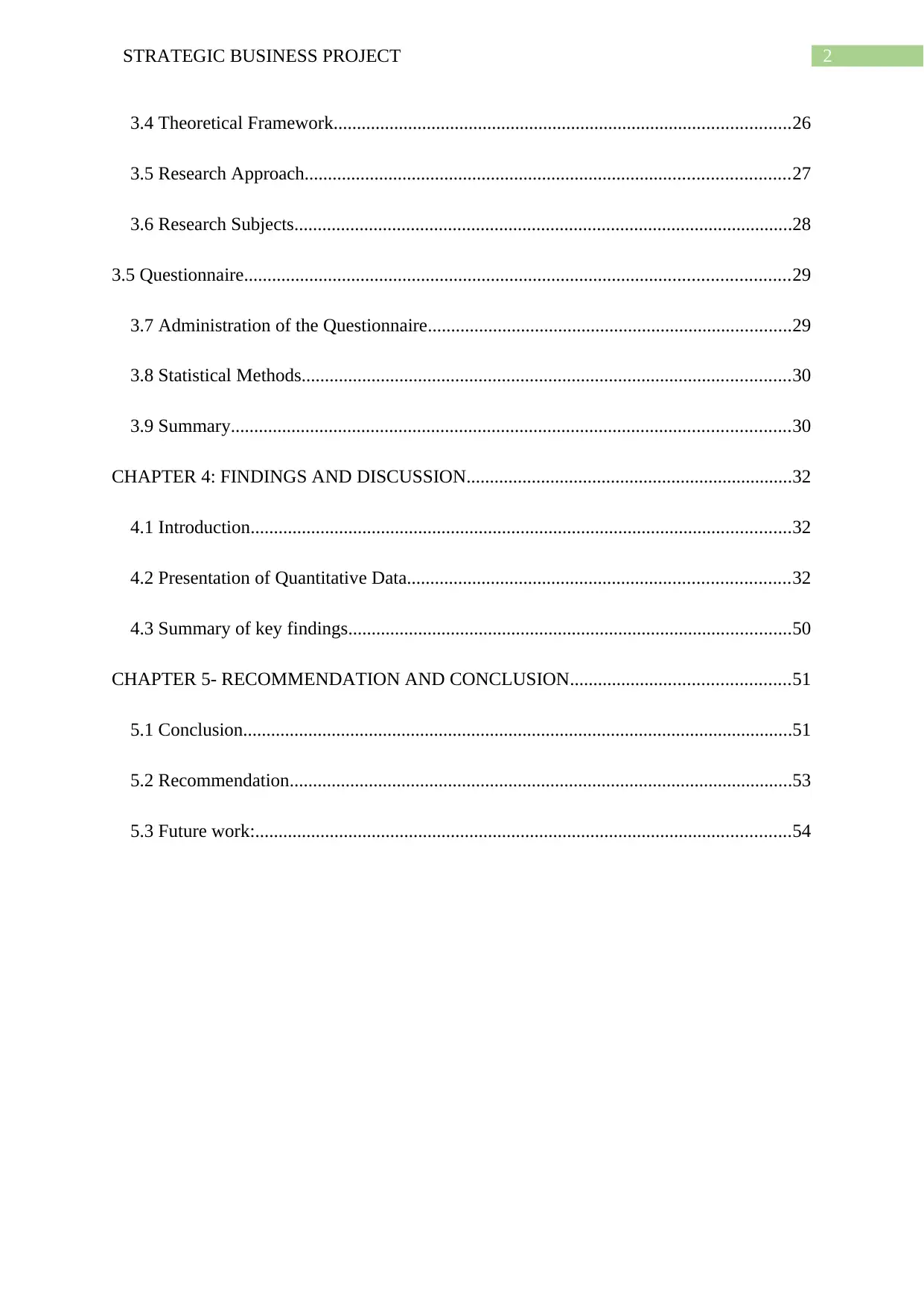
2STRATEGIC BUSINESS PROJECT
3.4 Theoretical Framework..................................................................................................26
3.5 Research Approach........................................................................................................27
3.6 Research Subjects...........................................................................................................28
3.5 Questionnaire.....................................................................................................................29
3.7 Administration of the Questionnaire..............................................................................29
3.8 Statistical Methods.........................................................................................................30
3.9 Summary........................................................................................................................30
CHAPTER 4: FINDINGS AND DISCUSSION......................................................................32
4.1 Introduction....................................................................................................................32
4.2 Presentation of Quantitative Data..................................................................................32
4.3 Summary of key findings...............................................................................................50
CHAPTER 5- RECOMMENDATION AND CONCLUSION...............................................51
5.1 Conclusion......................................................................................................................51
5.2 Recommendation............................................................................................................53
5.3 Future work:...................................................................................................................54
3.4 Theoretical Framework..................................................................................................26
3.5 Research Approach........................................................................................................27
3.6 Research Subjects...........................................................................................................28
3.5 Questionnaire.....................................................................................................................29
3.7 Administration of the Questionnaire..............................................................................29
3.8 Statistical Methods.........................................................................................................30
3.9 Summary........................................................................................................................30
CHAPTER 4: FINDINGS AND DISCUSSION......................................................................32
4.1 Introduction....................................................................................................................32
4.2 Presentation of Quantitative Data..................................................................................32
4.3 Summary of key findings...............................................................................................50
CHAPTER 5- RECOMMENDATION AND CONCLUSION...............................................51
5.1 Conclusion......................................................................................................................51
5.2 Recommendation............................................................................................................53
5.3 Future work:...................................................................................................................54
⊘ This is a preview!⊘
Do you want full access?
Subscribe today to unlock all pages.

Trusted by 1+ million students worldwide
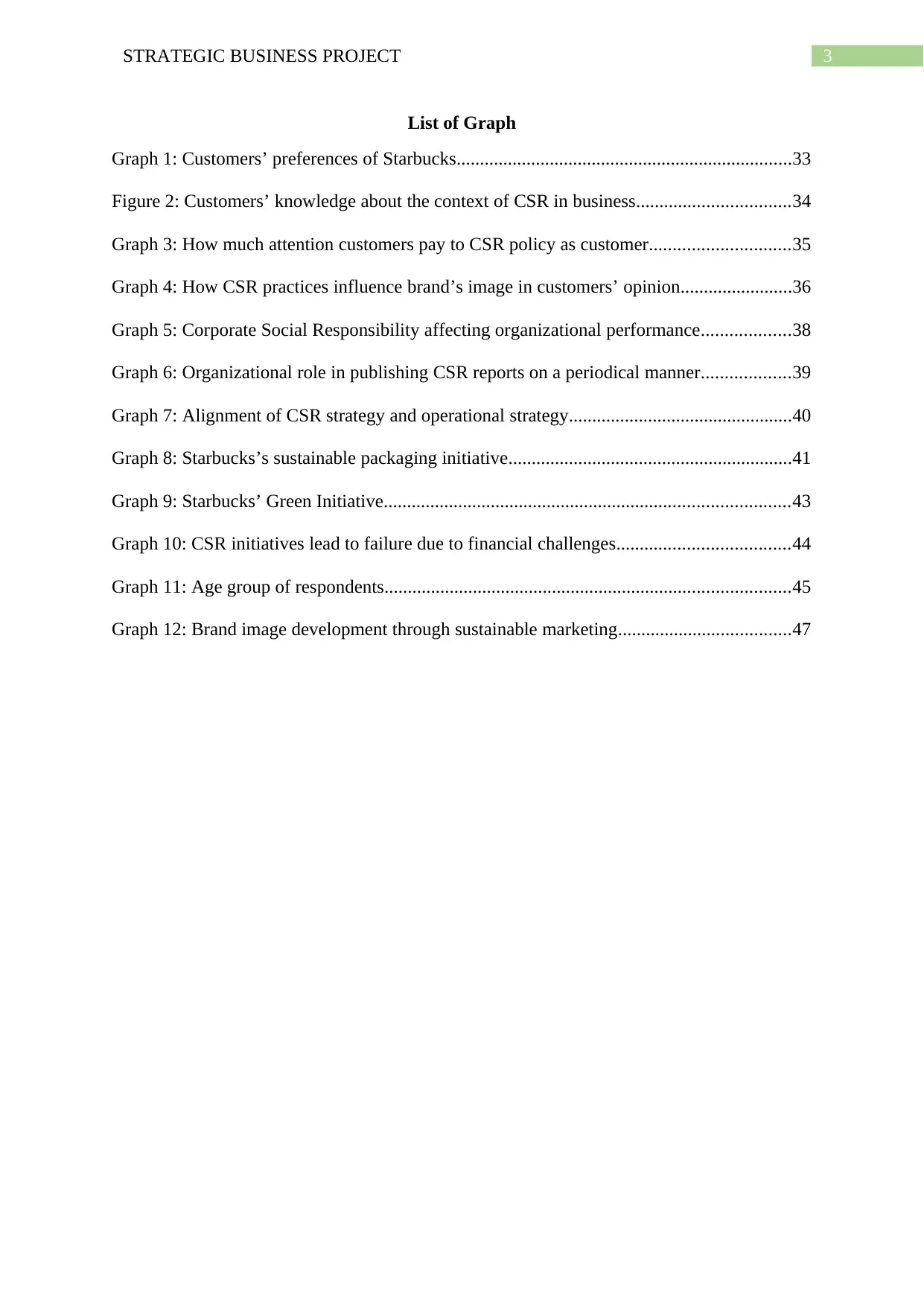
3STRATEGIC BUSINESS PROJECT
List of Graph
Graph 1: Customers’ preferences of Starbucks........................................................................33
Figure 2: Customers’ knowledge about the context of CSR in business.................................34
Graph 3: How much attention customers pay to CSR policy as customer..............................35
Graph 4: How CSR practices influence brand’s image in customers’ opinion........................36
Graph 5: Corporate Social Responsibility affecting organizational performance...................38
Graph 6: Organizational role in publishing CSR reports on a periodical manner...................39
Graph 7: Alignment of CSR strategy and operational strategy................................................40
Graph 8: Starbucks’s sustainable packaging initiative.............................................................41
Graph 9: Starbucks’ Green Initiative.......................................................................................43
Graph 10: CSR initiatives lead to failure due to financial challenges.....................................44
Graph 11: Age group of respondents.......................................................................................45
Graph 12: Brand image development through sustainable marketing.....................................47
List of Graph
Graph 1: Customers’ preferences of Starbucks........................................................................33
Figure 2: Customers’ knowledge about the context of CSR in business.................................34
Graph 3: How much attention customers pay to CSR policy as customer..............................35
Graph 4: How CSR practices influence brand’s image in customers’ opinion........................36
Graph 5: Corporate Social Responsibility affecting organizational performance...................38
Graph 6: Organizational role in publishing CSR reports on a periodical manner...................39
Graph 7: Alignment of CSR strategy and operational strategy................................................40
Graph 8: Starbucks’s sustainable packaging initiative.............................................................41
Graph 9: Starbucks’ Green Initiative.......................................................................................43
Graph 10: CSR initiatives lead to failure due to financial challenges.....................................44
Graph 11: Age group of respondents.......................................................................................45
Graph 12: Brand image development through sustainable marketing.....................................47
Paraphrase This Document
Need a fresh take? Get an instant paraphrase of this document with our AI Paraphraser
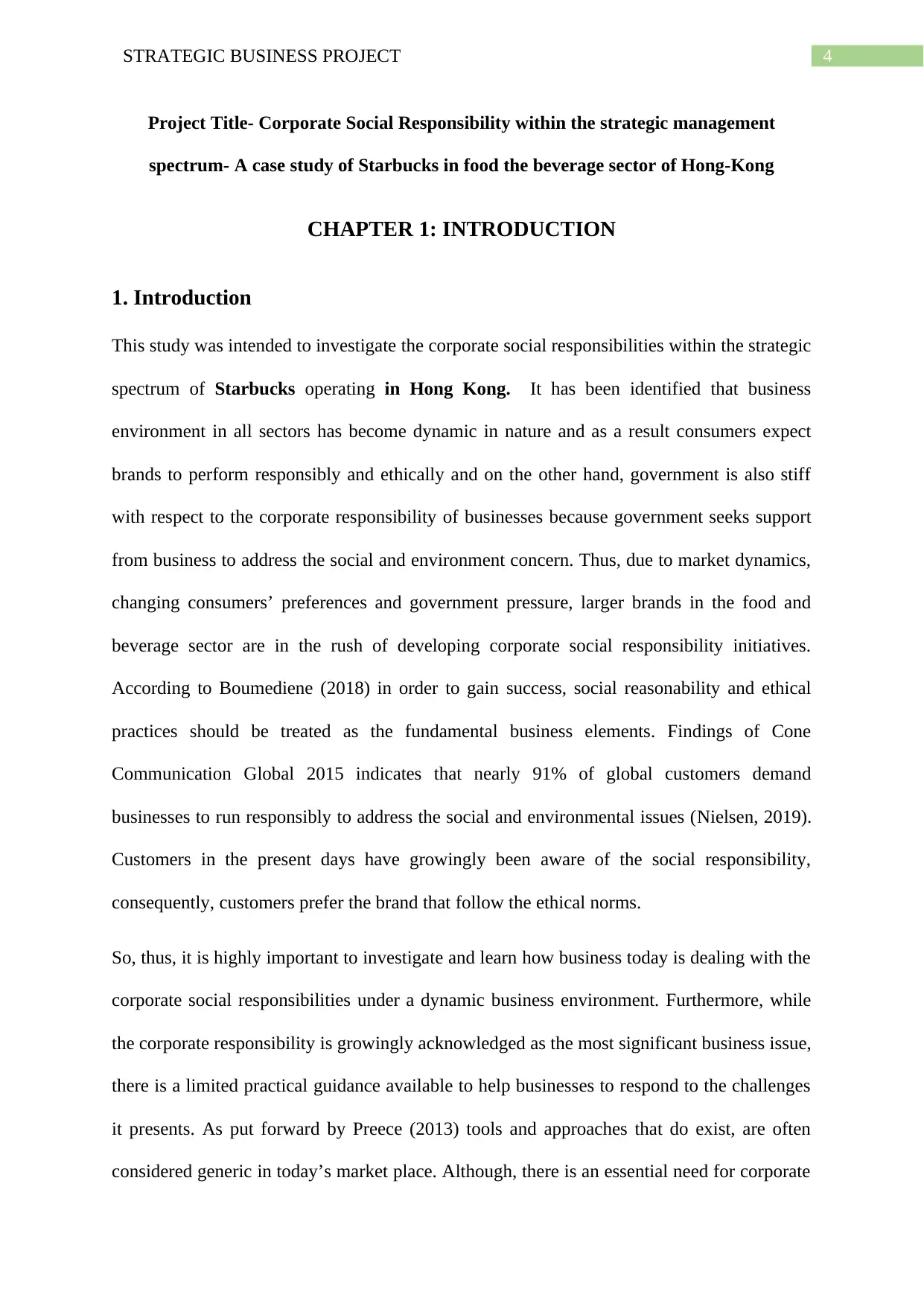
4STRATEGIC BUSINESS PROJECT
Project Title- Corporate Social Responsibility within the strategic management
spectrum- A case study of Starbucks in food the beverage sector of Hong-Kong
CHAPTER 1: INTRODUCTION
1. Introduction
This study was intended to investigate the corporate social responsibilities within the strategic
spectrum of Starbucks operating in Hong Kong. It has been identified that business
environment in all sectors has become dynamic in nature and as a result consumers expect
brands to perform responsibly and ethically and on the other hand, government is also stiff
with respect to the corporate responsibility of businesses because government seeks support
from business to address the social and environment concern. Thus, due to market dynamics,
changing consumers’ preferences and government pressure, larger brands in the food and
beverage sector are in the rush of developing corporate social responsibility initiatives.
According to Boumediene (2018) in order to gain success, social reasonability and ethical
practices should be treated as the fundamental business elements. Findings of Cone
Communication Global 2015 indicates that nearly 91% of global customers demand
businesses to run responsibly to address the social and environmental issues (Nielsen, 2019).
Customers in the present days have growingly been aware of the social responsibility,
consequently, customers prefer the brand that follow the ethical norms.
So, thus, it is highly important to investigate and learn how business today is dealing with the
corporate social responsibilities under a dynamic business environment. Furthermore, while
the corporate responsibility is growingly acknowledged as the most significant business issue,
there is a limited practical guidance available to help businesses to respond to the challenges
it presents. As put forward by Preece (2013) tools and approaches that do exist, are often
considered generic in today’s market place. Although, there is an essential need for corporate
Project Title- Corporate Social Responsibility within the strategic management
spectrum- A case study of Starbucks in food the beverage sector of Hong-Kong
CHAPTER 1: INTRODUCTION
1. Introduction
This study was intended to investigate the corporate social responsibilities within the strategic
spectrum of Starbucks operating in Hong Kong. It has been identified that business
environment in all sectors has become dynamic in nature and as a result consumers expect
brands to perform responsibly and ethically and on the other hand, government is also stiff
with respect to the corporate responsibility of businesses because government seeks support
from business to address the social and environment concern. Thus, due to market dynamics,
changing consumers’ preferences and government pressure, larger brands in the food and
beverage sector are in the rush of developing corporate social responsibility initiatives.
According to Boumediene (2018) in order to gain success, social reasonability and ethical
practices should be treated as the fundamental business elements. Findings of Cone
Communication Global 2015 indicates that nearly 91% of global customers demand
businesses to run responsibly to address the social and environmental issues (Nielsen, 2019).
Customers in the present days have growingly been aware of the social responsibility,
consequently, customers prefer the brand that follow the ethical norms.
So, thus, it is highly important to investigate and learn how business today is dealing with the
corporate social responsibilities under a dynamic business environment. Furthermore, while
the corporate responsibility is growingly acknowledged as the most significant business issue,
there is a limited practical guidance available to help businesses to respond to the challenges
it presents. As put forward by Preece (2013) tools and approaches that do exist, are often
considered generic in today’s market place. Although, there is an essential need for corporate
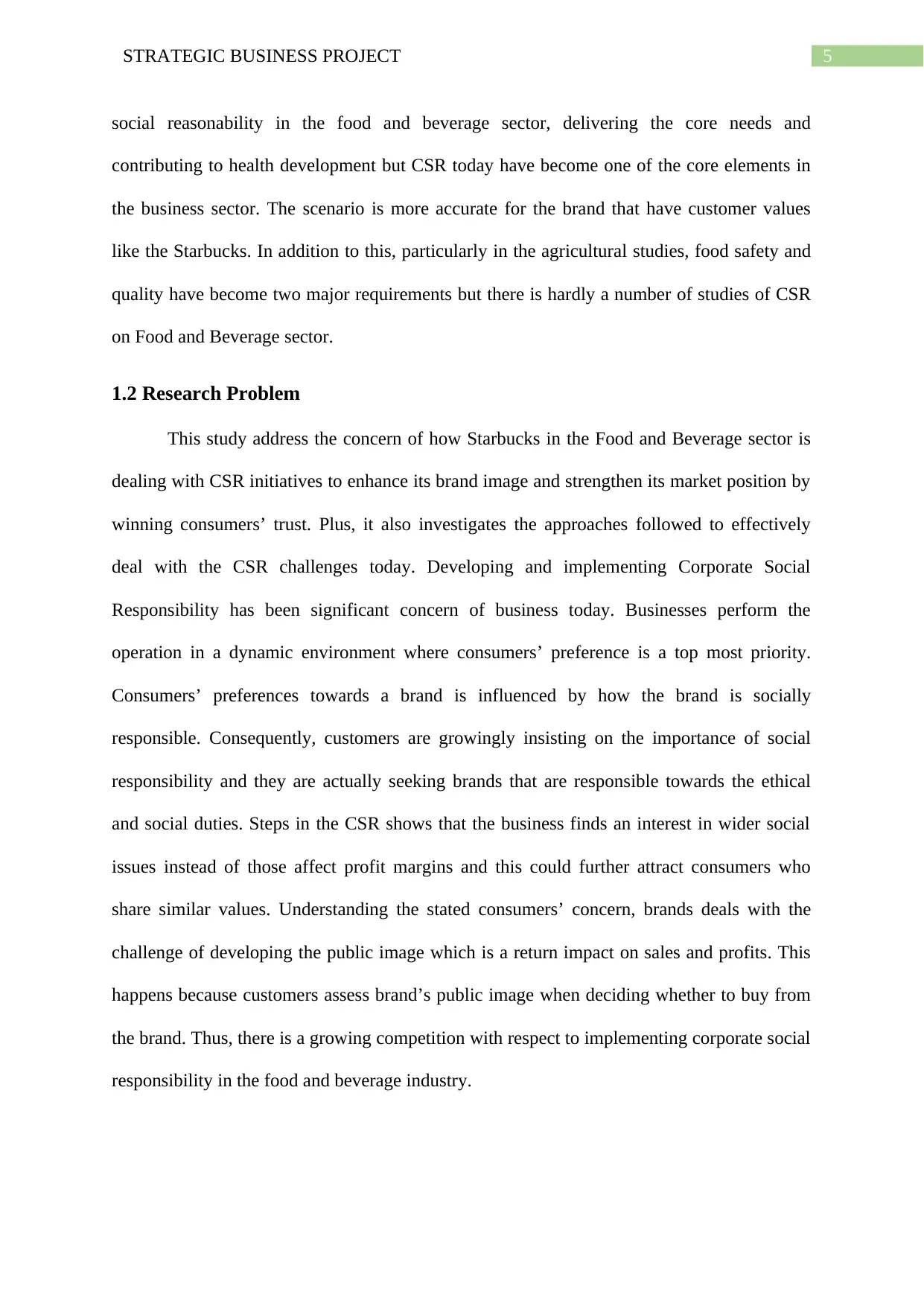
5STRATEGIC BUSINESS PROJECT
social reasonability in the food and beverage sector, delivering the core needs and
contributing to health development but CSR today have become one of the core elements in
the business sector. The scenario is more accurate for the brand that have customer values
like the Starbucks. In addition to this, particularly in the agricultural studies, food safety and
quality have become two major requirements but there is hardly a number of studies of CSR
on Food and Beverage sector.
1.2 Research Problem
This study address the concern of how Starbucks in the Food and Beverage sector is
dealing with CSR initiatives to enhance its brand image and strengthen its market position by
winning consumers’ trust. Plus, it also investigates the approaches followed to effectively
deal with the CSR challenges today. Developing and implementing Corporate Social
Responsibility has been significant concern of business today. Businesses perform the
operation in a dynamic environment where consumers’ preference is a top most priority.
Consumers’ preferences towards a brand is influenced by how the brand is socially
responsible. Consequently, customers are growingly insisting on the importance of social
responsibility and they are actually seeking brands that are responsible towards the ethical
and social duties. Steps in the CSR shows that the business finds an interest in wider social
issues instead of those affect profit margins and this could further attract consumers who
share similar values. Understanding the stated consumers’ concern, brands deals with the
challenge of developing the public image which is a return impact on sales and profits. This
happens because customers assess brand’s public image when deciding whether to buy from
the brand. Thus, there is a growing competition with respect to implementing corporate social
responsibility in the food and beverage industry.
social reasonability in the food and beverage sector, delivering the core needs and
contributing to health development but CSR today have become one of the core elements in
the business sector. The scenario is more accurate for the brand that have customer values
like the Starbucks. In addition to this, particularly in the agricultural studies, food safety and
quality have become two major requirements but there is hardly a number of studies of CSR
on Food and Beverage sector.
1.2 Research Problem
This study address the concern of how Starbucks in the Food and Beverage sector is
dealing with CSR initiatives to enhance its brand image and strengthen its market position by
winning consumers’ trust. Plus, it also investigates the approaches followed to effectively
deal with the CSR challenges today. Developing and implementing Corporate Social
Responsibility has been significant concern of business today. Businesses perform the
operation in a dynamic environment where consumers’ preference is a top most priority.
Consumers’ preferences towards a brand is influenced by how the brand is socially
responsible. Consequently, customers are growingly insisting on the importance of social
responsibility and they are actually seeking brands that are responsible towards the ethical
and social duties. Steps in the CSR shows that the business finds an interest in wider social
issues instead of those affect profit margins and this could further attract consumers who
share similar values. Understanding the stated consumers’ concern, brands deals with the
challenge of developing the public image which is a return impact on sales and profits. This
happens because customers assess brand’s public image when deciding whether to buy from
the brand. Thus, there is a growing competition with respect to implementing corporate social
responsibility in the food and beverage industry.
⊘ This is a preview!⊘
Do you want full access?
Subscribe today to unlock all pages.

Trusted by 1+ million students worldwide
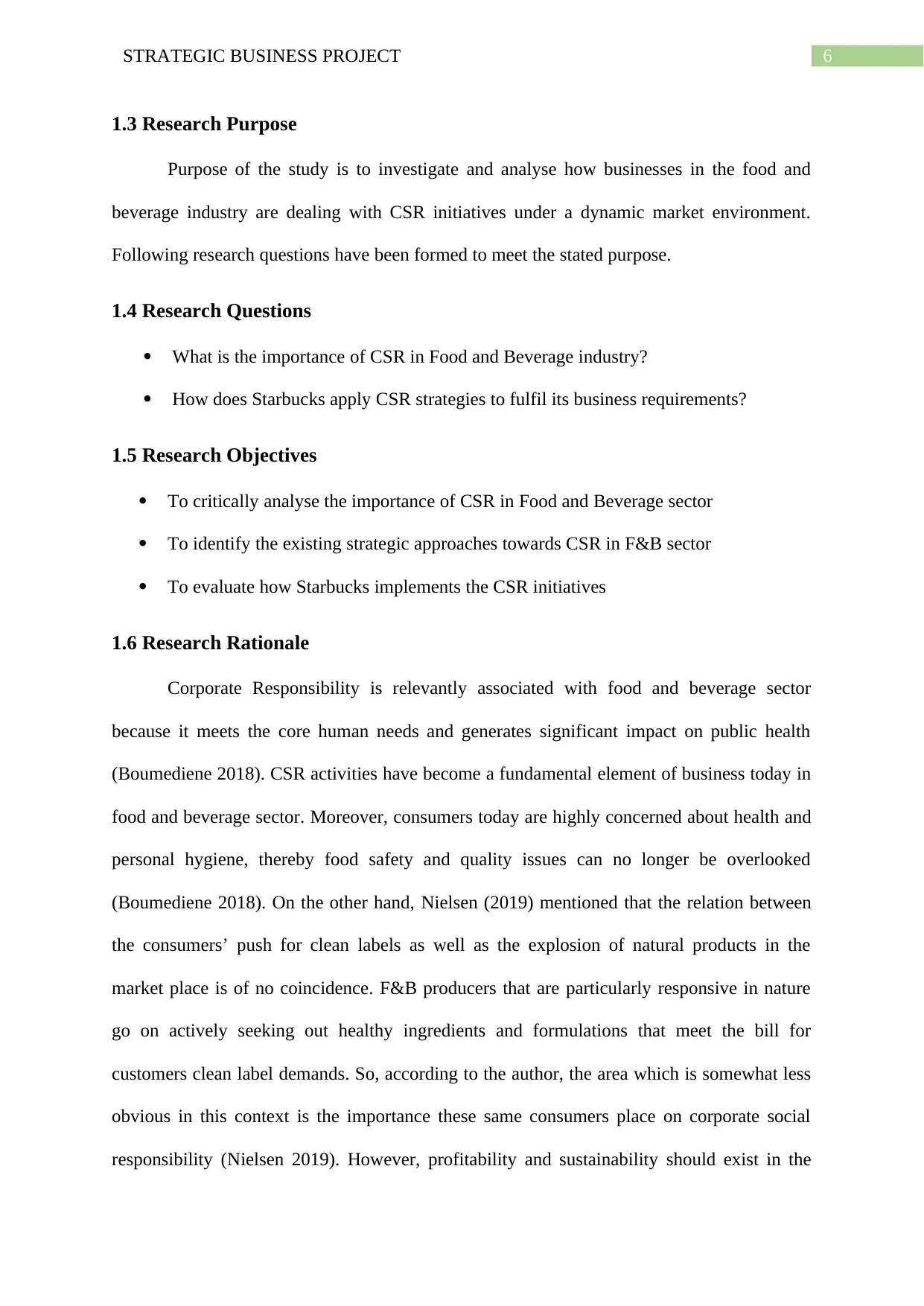
6STRATEGIC BUSINESS PROJECT
1.3 Research Purpose
Purpose of the study is to investigate and analyse how businesses in the food and
beverage industry are dealing with CSR initiatives under a dynamic market environment.
Following research questions have been formed to meet the stated purpose.
1.4 Research Questions
What is the importance of CSR in Food and Beverage industry?
How does Starbucks apply CSR strategies to fulfil its business requirements?
1.5 Research Objectives
To critically analyse the importance of CSR in Food and Beverage sector
To identify the existing strategic approaches towards CSR in F&B sector
To evaluate how Starbucks implements the CSR initiatives
1.6 Research Rationale
Corporate Responsibility is relevantly associated with food and beverage sector
because it meets the core human needs and generates significant impact on public health
(Boumediene 2018). CSR activities have become a fundamental element of business today in
food and beverage sector. Moreover, consumers today are highly concerned about health and
personal hygiene, thereby food safety and quality issues can no longer be overlooked
(Boumediene 2018). On the other hand, Nielsen (2019) mentioned that the relation between
the consumers’ push for clean labels as well as the explosion of natural products in the
market place is of no coincidence. F&B producers that are particularly responsive in nature
go on actively seeking out healthy ingredients and formulations that meet the bill for
customers clean label demands. So, according to the author, the area which is somewhat less
obvious in this context is the importance these same consumers place on corporate social
responsibility (Nielsen 2019). However, profitability and sustainability should exist in the
1.3 Research Purpose
Purpose of the study is to investigate and analyse how businesses in the food and
beverage industry are dealing with CSR initiatives under a dynamic market environment.
Following research questions have been formed to meet the stated purpose.
1.4 Research Questions
What is the importance of CSR in Food and Beverage industry?
How does Starbucks apply CSR strategies to fulfil its business requirements?
1.5 Research Objectives
To critically analyse the importance of CSR in Food and Beverage sector
To identify the existing strategic approaches towards CSR in F&B sector
To evaluate how Starbucks implements the CSR initiatives
1.6 Research Rationale
Corporate Responsibility is relevantly associated with food and beverage sector
because it meets the core human needs and generates significant impact on public health
(Boumediene 2018). CSR activities have become a fundamental element of business today in
food and beverage sector. Moreover, consumers today are highly concerned about health and
personal hygiene, thereby food safety and quality issues can no longer be overlooked
(Boumediene 2018). On the other hand, Nielsen (2019) mentioned that the relation between
the consumers’ push for clean labels as well as the explosion of natural products in the
market place is of no coincidence. F&B producers that are particularly responsive in nature
go on actively seeking out healthy ingredients and formulations that meet the bill for
customers clean label demands. So, according to the author, the area which is somewhat less
obvious in this context is the importance these same consumers place on corporate social
responsibility (Nielsen 2019). However, profitability and sustainability should exist in the
Paraphrase This Document
Need a fresh take? Get an instant paraphrase of this document with our AI Paraphraser
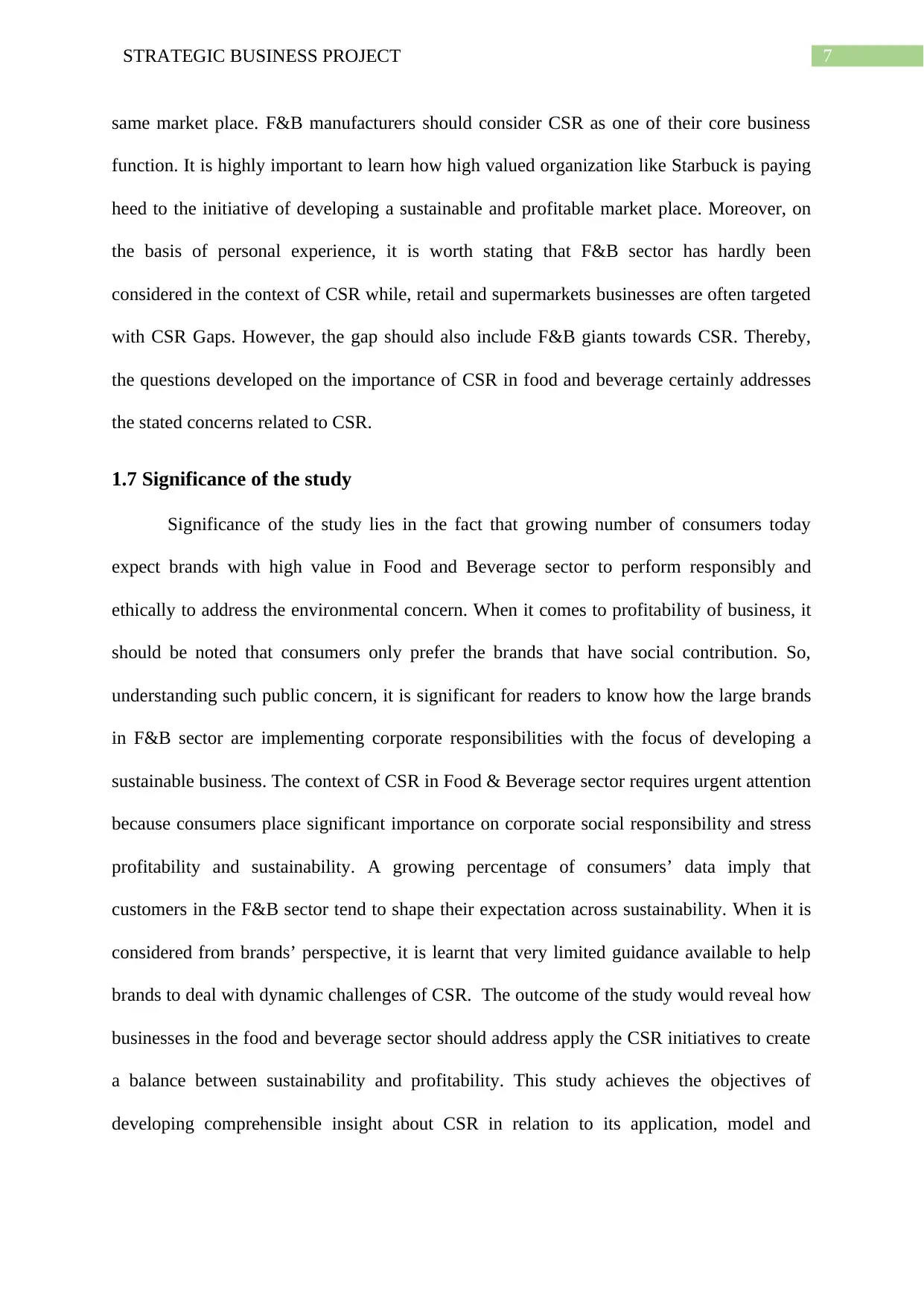
7STRATEGIC BUSINESS PROJECT
same market place. F&B manufacturers should consider CSR as one of their core business
function. It is highly important to learn how high valued organization like Starbuck is paying
heed to the initiative of developing a sustainable and profitable market place. Moreover, on
the basis of personal experience, it is worth stating that F&B sector has hardly been
considered in the context of CSR while, retail and supermarkets businesses are often targeted
with CSR Gaps. However, the gap should also include F&B giants towards CSR. Thereby,
the questions developed on the importance of CSR in food and beverage certainly addresses
the stated concerns related to CSR.
1.7 Significance of the study
Significance of the study lies in the fact that growing number of consumers today
expect brands with high value in Food and Beverage sector to perform responsibly and
ethically to address the environmental concern. When it comes to profitability of business, it
should be noted that consumers only prefer the brands that have social contribution. So,
understanding such public concern, it is significant for readers to know how the large brands
in F&B sector are implementing corporate responsibilities with the focus of developing a
sustainable business. The context of CSR in Food & Beverage sector requires urgent attention
because consumers place significant importance on corporate social responsibility and stress
profitability and sustainability. A growing percentage of consumers’ data imply that
customers in the F&B sector tend to shape their expectation across sustainability. When it is
considered from brands’ perspective, it is learnt that very limited guidance available to help
brands to deal with dynamic challenges of CSR. The outcome of the study would reveal how
businesses in the food and beverage sector should address apply the CSR initiatives to create
a balance between sustainability and profitability. This study achieves the objectives of
developing comprehensible insight about CSR in relation to its application, model and
same market place. F&B manufacturers should consider CSR as one of their core business
function. It is highly important to learn how high valued organization like Starbuck is paying
heed to the initiative of developing a sustainable and profitable market place. Moreover, on
the basis of personal experience, it is worth stating that F&B sector has hardly been
considered in the context of CSR while, retail and supermarkets businesses are often targeted
with CSR Gaps. However, the gap should also include F&B giants towards CSR. Thereby,
the questions developed on the importance of CSR in food and beverage certainly addresses
the stated concerns related to CSR.
1.7 Significance of the study
Significance of the study lies in the fact that growing number of consumers today
expect brands with high value in Food and Beverage sector to perform responsibly and
ethically to address the environmental concern. When it comes to profitability of business, it
should be noted that consumers only prefer the brands that have social contribution. So,
understanding such public concern, it is significant for readers to know how the large brands
in F&B sector are implementing corporate responsibilities with the focus of developing a
sustainable business. The context of CSR in Food & Beverage sector requires urgent attention
because consumers place significant importance on corporate social responsibility and stress
profitability and sustainability. A growing percentage of consumers’ data imply that
customers in the F&B sector tend to shape their expectation across sustainability. When it is
considered from brands’ perspective, it is learnt that very limited guidance available to help
brands to deal with dynamic challenges of CSR. The outcome of the study would reveal how
businesses in the food and beverage sector should address apply the CSR initiatives to create
a balance between sustainability and profitability. This study achieves the objectives of
developing comprehensible insight about CSR in relation to its application, model and
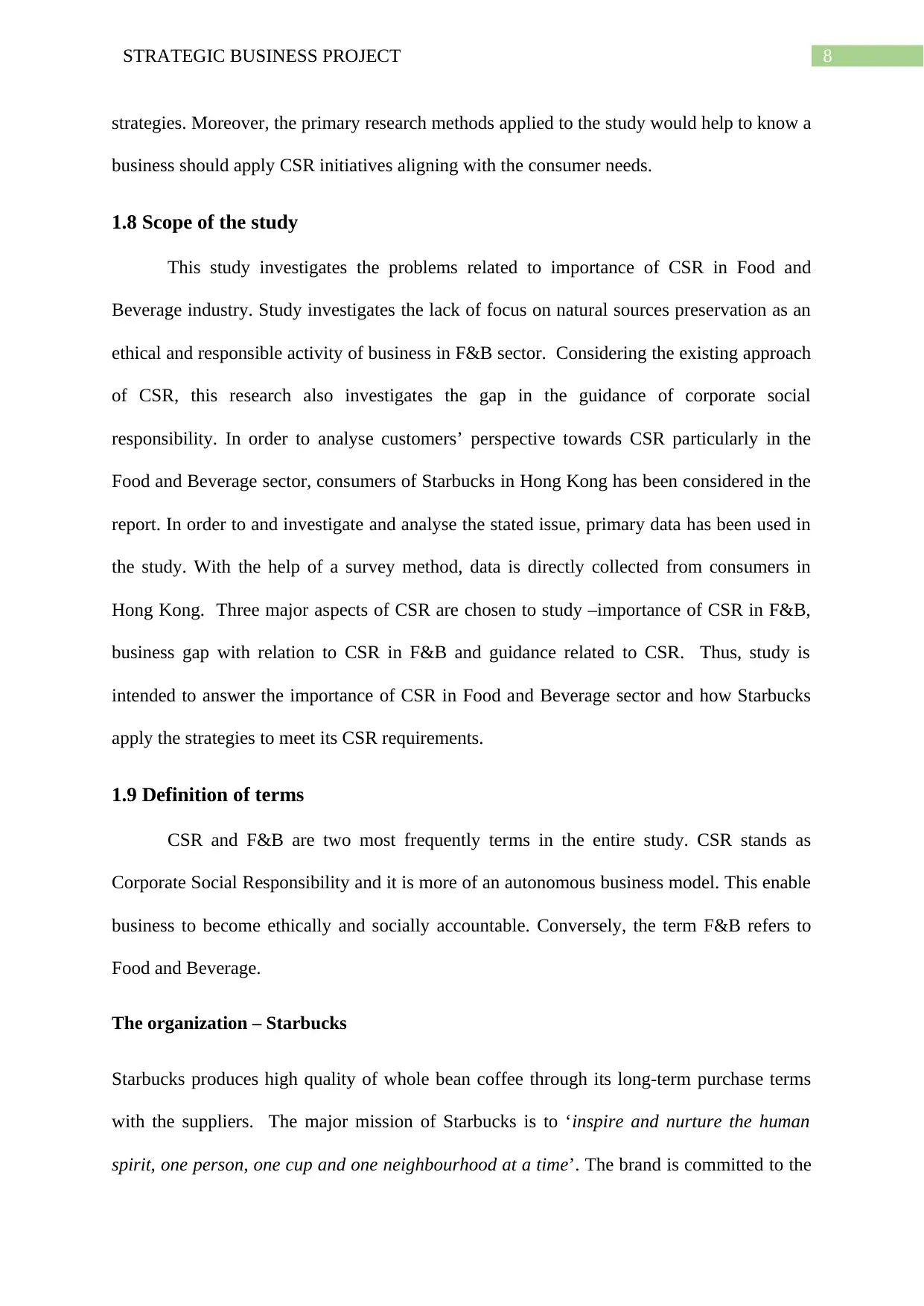
8STRATEGIC BUSINESS PROJECT
strategies. Moreover, the primary research methods applied to the study would help to know a
business should apply CSR initiatives aligning with the consumer needs.
1.8 Scope of the study
This study investigates the problems related to importance of CSR in Food and
Beverage industry. Study investigates the lack of focus on natural sources preservation as an
ethical and responsible activity of business in F&B sector. Considering the existing approach
of CSR, this research also investigates the gap in the guidance of corporate social
responsibility. In order to analyse customers’ perspective towards CSR particularly in the
Food and Beverage sector, consumers of Starbucks in Hong Kong has been considered in the
report. In order to and investigate and analyse the stated issue, primary data has been used in
the study. With the help of a survey method, data is directly collected from consumers in
Hong Kong. Three major aspects of CSR are chosen to study –importance of CSR in F&B,
business gap with relation to CSR in F&B and guidance related to CSR. Thus, study is
intended to answer the importance of CSR in Food and Beverage sector and how Starbucks
apply the strategies to meet its CSR requirements.
1.9 Definition of terms
CSR and F&B are two most frequently terms in the entire study. CSR stands as
Corporate Social Responsibility and it is more of an autonomous business model. This enable
business to become ethically and socially accountable. Conversely, the term F&B refers to
Food and Beverage.
The organization – Starbucks
Starbucks produces high quality of whole bean coffee through its long-term purchase terms
with the suppliers. The major mission of Starbucks is to ‘inspire and nurture the human
spirit, one person, one cup and one neighbourhood at a time’. The brand is committed to the
strategies. Moreover, the primary research methods applied to the study would help to know a
business should apply CSR initiatives aligning with the consumer needs.
1.8 Scope of the study
This study investigates the problems related to importance of CSR in Food and
Beverage industry. Study investigates the lack of focus on natural sources preservation as an
ethical and responsible activity of business in F&B sector. Considering the existing approach
of CSR, this research also investigates the gap in the guidance of corporate social
responsibility. In order to analyse customers’ perspective towards CSR particularly in the
Food and Beverage sector, consumers of Starbucks in Hong Kong has been considered in the
report. In order to and investigate and analyse the stated issue, primary data has been used in
the study. With the help of a survey method, data is directly collected from consumers in
Hong Kong. Three major aspects of CSR are chosen to study –importance of CSR in F&B,
business gap with relation to CSR in F&B and guidance related to CSR. Thus, study is
intended to answer the importance of CSR in Food and Beverage sector and how Starbucks
apply the strategies to meet its CSR requirements.
1.9 Definition of terms
CSR and F&B are two most frequently terms in the entire study. CSR stands as
Corporate Social Responsibility and it is more of an autonomous business model. This enable
business to become ethically and socially accountable. Conversely, the term F&B refers to
Food and Beverage.
The organization – Starbucks
Starbucks produces high quality of whole bean coffee through its long-term purchase terms
with the suppliers. The major mission of Starbucks is to ‘inspire and nurture the human
spirit, one person, one cup and one neighbourhood at a time’. The brand is committed to the
⊘ This is a preview!⊘
Do you want full access?
Subscribe today to unlock all pages.

Trusted by 1+ million students worldwide
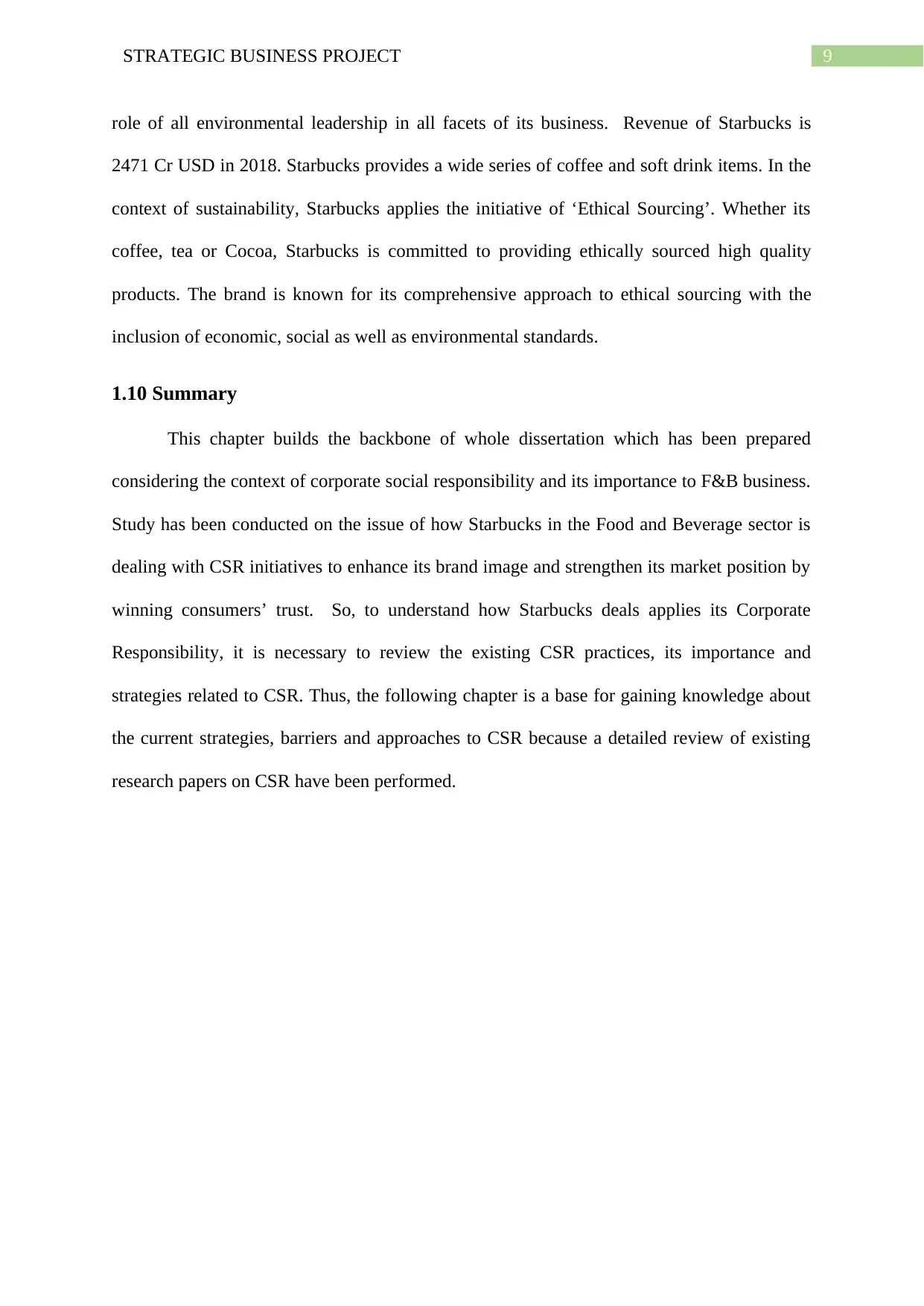
9STRATEGIC BUSINESS PROJECT
role of all environmental leadership in all facets of its business. Revenue of Starbucks is
2471 Cr USD in 2018. Starbucks provides a wide series of coffee and soft drink items. In the
context of sustainability, Starbucks applies the initiative of ‘Ethical Sourcing’. Whether its
coffee, tea or Cocoa, Starbucks is committed to providing ethically sourced high quality
products. The brand is known for its comprehensive approach to ethical sourcing with the
inclusion of economic, social as well as environmental standards.
1.10 Summary
This chapter builds the backbone of whole dissertation which has been prepared
considering the context of corporate social responsibility and its importance to F&B business.
Study has been conducted on the issue of how Starbucks in the Food and Beverage sector is
dealing with CSR initiatives to enhance its brand image and strengthen its market position by
winning consumers’ trust. So, to understand how Starbucks deals applies its Corporate
Responsibility, it is necessary to review the existing CSR practices, its importance and
strategies related to CSR. Thus, the following chapter is a base for gaining knowledge about
the current strategies, barriers and approaches to CSR because a detailed review of existing
research papers on CSR have been performed.
role of all environmental leadership in all facets of its business. Revenue of Starbucks is
2471 Cr USD in 2018. Starbucks provides a wide series of coffee and soft drink items. In the
context of sustainability, Starbucks applies the initiative of ‘Ethical Sourcing’. Whether its
coffee, tea or Cocoa, Starbucks is committed to providing ethically sourced high quality
products. The brand is known for its comprehensive approach to ethical sourcing with the
inclusion of economic, social as well as environmental standards.
1.10 Summary
This chapter builds the backbone of whole dissertation which has been prepared
considering the context of corporate social responsibility and its importance to F&B business.
Study has been conducted on the issue of how Starbucks in the Food and Beverage sector is
dealing with CSR initiatives to enhance its brand image and strengthen its market position by
winning consumers’ trust. So, to understand how Starbucks deals applies its Corporate
Responsibility, it is necessary to review the existing CSR practices, its importance and
strategies related to CSR. Thus, the following chapter is a base for gaining knowledge about
the current strategies, barriers and approaches to CSR because a detailed review of existing
research papers on CSR have been performed.
Paraphrase This Document
Need a fresh take? Get an instant paraphrase of this document with our AI Paraphraser
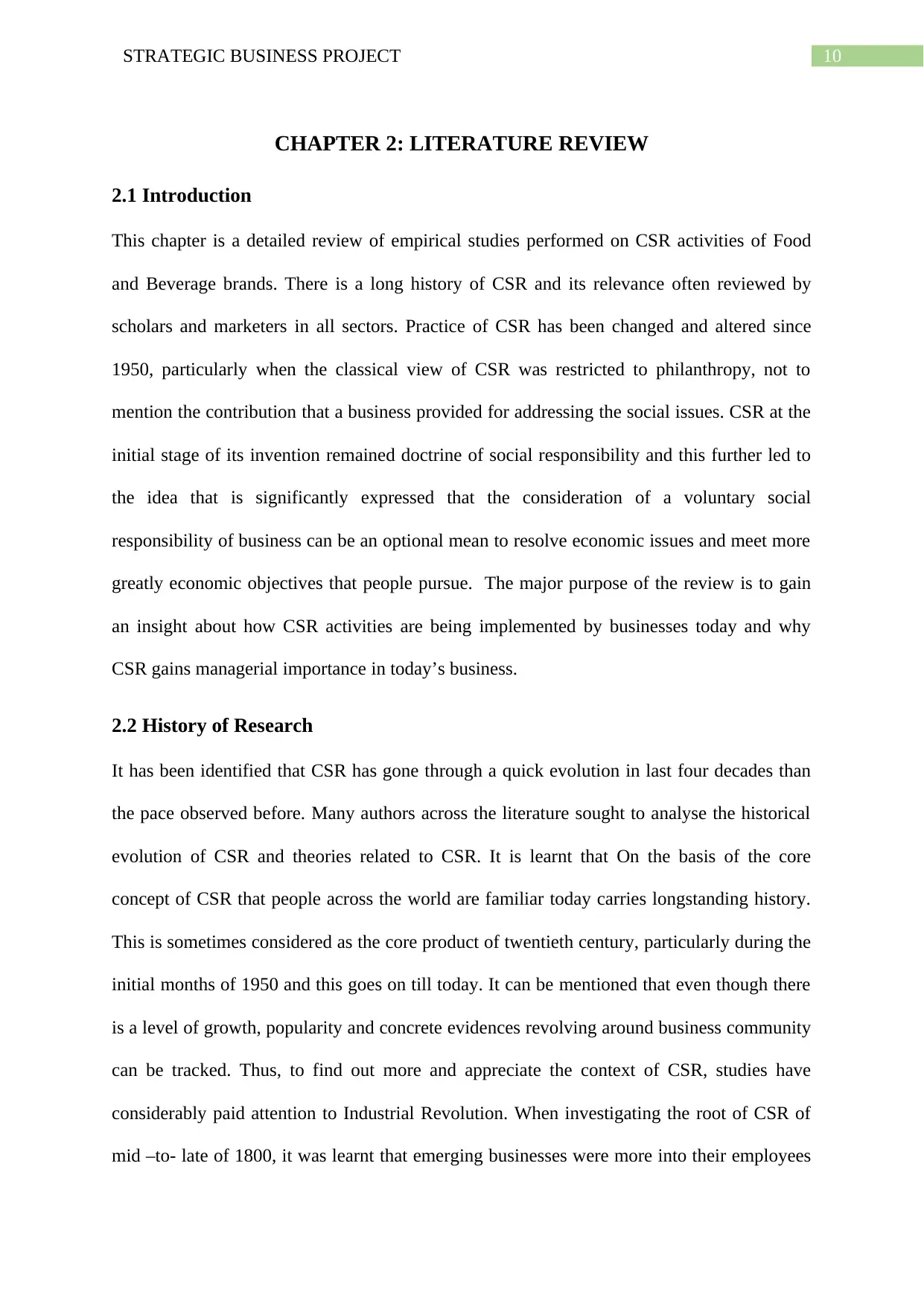
10STRATEGIC BUSINESS PROJECT
CHAPTER 2: LITERATURE REVIEW
2.1 Introduction
This chapter is a detailed review of empirical studies performed on CSR activities of Food
and Beverage brands. There is a long history of CSR and its relevance often reviewed by
scholars and marketers in all sectors. Practice of CSR has been changed and altered since
1950, particularly when the classical view of CSR was restricted to philanthropy, not to
mention the contribution that a business provided for addressing the social issues. CSR at the
initial stage of its invention remained doctrine of social responsibility and this further led to
the idea that is significantly expressed that the consideration of a voluntary social
responsibility of business can be an optional mean to resolve economic issues and meet more
greatly economic objectives that people pursue. The major purpose of the review is to gain
an insight about how CSR activities are being implemented by businesses today and why
CSR gains managerial importance in today’s business.
2.2 History of Research
It has been identified that CSR has gone through a quick evolution in last four decades than
the pace observed before. Many authors across the literature sought to analyse the historical
evolution of CSR and theories related to CSR. It is learnt that On the basis of the core
concept of CSR that people across the world are familiar today carries longstanding history.
This is sometimes considered as the core product of twentieth century, particularly during the
initial months of 1950 and this goes on till today. It can be mentioned that even though there
is a level of growth, popularity and concrete evidences revolving around business community
can be tracked. Thus, to find out more and appreciate the context of CSR, studies have
considerably paid attention to Industrial Revolution. When investigating the root of CSR of
mid –to- late of 1800, it was learnt that emerging businesses were more into their employees
CHAPTER 2: LITERATURE REVIEW
2.1 Introduction
This chapter is a detailed review of empirical studies performed on CSR activities of Food
and Beverage brands. There is a long history of CSR and its relevance often reviewed by
scholars and marketers in all sectors. Practice of CSR has been changed and altered since
1950, particularly when the classical view of CSR was restricted to philanthropy, not to
mention the contribution that a business provided for addressing the social issues. CSR at the
initial stage of its invention remained doctrine of social responsibility and this further led to
the idea that is significantly expressed that the consideration of a voluntary social
responsibility of business can be an optional mean to resolve economic issues and meet more
greatly economic objectives that people pursue. The major purpose of the review is to gain
an insight about how CSR activities are being implemented by businesses today and why
CSR gains managerial importance in today’s business.
2.2 History of Research
It has been identified that CSR has gone through a quick evolution in last four decades than
the pace observed before. Many authors across the literature sought to analyse the historical
evolution of CSR and theories related to CSR. It is learnt that On the basis of the core
concept of CSR that people across the world are familiar today carries longstanding history.
This is sometimes considered as the core product of twentieth century, particularly during the
initial months of 1950 and this goes on till today. It can be mentioned that even though there
is a level of growth, popularity and concrete evidences revolving around business community
can be tracked. Thus, to find out more and appreciate the context of CSR, studies have
considerably paid attention to Industrial Revolution. When investigating the root of CSR of
mid –to- late of 1800, it was learnt that emerging businesses were more into their employees
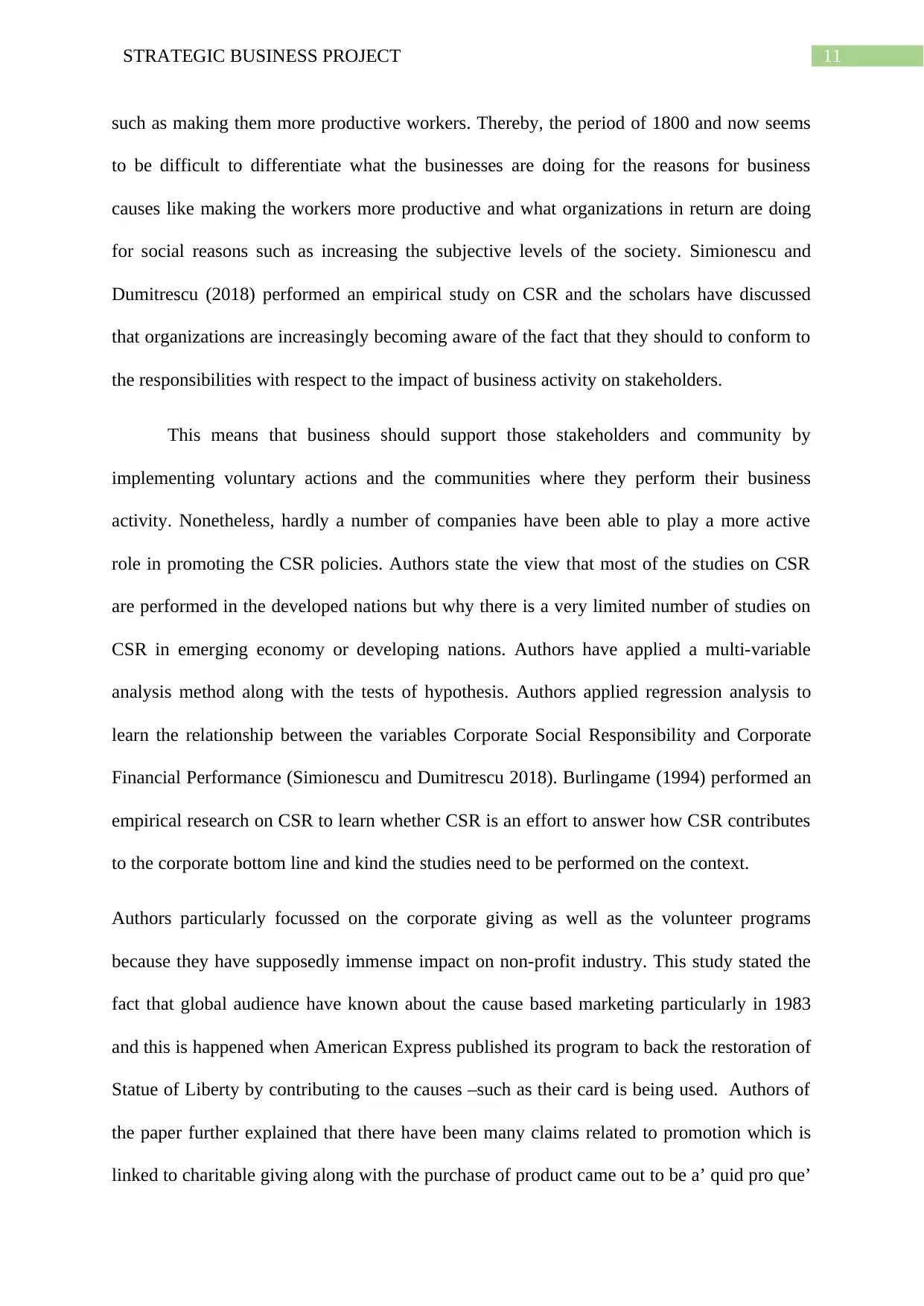
11STRATEGIC BUSINESS PROJECT
such as making them more productive workers. Thereby, the period of 1800 and now seems
to be difficult to differentiate what the businesses are doing for the reasons for business
causes like making the workers more productive and what organizations in return are doing
for social reasons such as increasing the subjective levels of the society. Simionescu and
Dumitrescu (2018) performed an empirical study on CSR and the scholars have discussed
that organizations are increasingly becoming aware of the fact that they should to conform to
the responsibilities with respect to the impact of business activity on stakeholders.
This means that business should support those stakeholders and community by
implementing voluntary actions and the communities where they perform their business
activity. Nonetheless, hardly a number of companies have been able to play a more active
role in promoting the CSR policies. Authors state the view that most of the studies on CSR
are performed in the developed nations but why there is a very limited number of studies on
CSR in emerging economy or developing nations. Authors have applied a multi-variable
analysis method along with the tests of hypothesis. Authors applied regression analysis to
learn the relationship between the variables Corporate Social Responsibility and Corporate
Financial Performance (Simionescu and Dumitrescu 2018). Burlingame (1994) performed an
empirical research on CSR to learn whether CSR is an effort to answer how CSR contributes
to the corporate bottom line and kind the studies need to be performed on the context.
Authors particularly focussed on the corporate giving as well as the volunteer programs
because they have supposedly immense impact on non-profit industry. This study stated the
fact that global audience have known about the cause based marketing particularly in 1983
and this is happened when American Express published its program to back the restoration of
Statue of Liberty by contributing to the causes –such as their card is being used. Authors of
the paper further explained that there have been many claims related to promotion which is
linked to charitable giving along with the purchase of product came out to be a’ quid pro que’
such as making them more productive workers. Thereby, the period of 1800 and now seems
to be difficult to differentiate what the businesses are doing for the reasons for business
causes like making the workers more productive and what organizations in return are doing
for social reasons such as increasing the subjective levels of the society. Simionescu and
Dumitrescu (2018) performed an empirical study on CSR and the scholars have discussed
that organizations are increasingly becoming aware of the fact that they should to conform to
the responsibilities with respect to the impact of business activity on stakeholders.
This means that business should support those stakeholders and community by
implementing voluntary actions and the communities where they perform their business
activity. Nonetheless, hardly a number of companies have been able to play a more active
role in promoting the CSR policies. Authors state the view that most of the studies on CSR
are performed in the developed nations but why there is a very limited number of studies on
CSR in emerging economy or developing nations. Authors have applied a multi-variable
analysis method along with the tests of hypothesis. Authors applied regression analysis to
learn the relationship between the variables Corporate Social Responsibility and Corporate
Financial Performance (Simionescu and Dumitrescu 2018). Burlingame (1994) performed an
empirical research on CSR to learn whether CSR is an effort to answer how CSR contributes
to the corporate bottom line and kind the studies need to be performed on the context.
Authors particularly focussed on the corporate giving as well as the volunteer programs
because they have supposedly immense impact on non-profit industry. This study stated the
fact that global audience have known about the cause based marketing particularly in 1983
and this is happened when American Express published its program to back the restoration of
Statue of Liberty by contributing to the causes –such as their card is being used. Authors of
the paper further explained that there have been many claims related to promotion which is
linked to charitable giving along with the purchase of product came out to be a’ quid pro que’
⊘ This is a preview!⊘
Do you want full access?
Subscribe today to unlock all pages.

Trusted by 1+ million students worldwide
1 out of 60
Related Documents
Your All-in-One AI-Powered Toolkit for Academic Success.
+13062052269
info@desklib.com
Available 24*7 on WhatsApp / Email
![[object Object]](/_next/static/media/star-bottom.7253800d.svg)
Unlock your academic potential
Copyright © 2020–2025 A2Z Services. All Rights Reserved. Developed and managed by ZUCOL.





